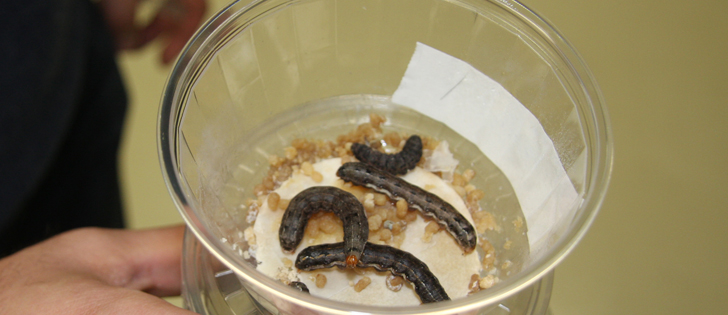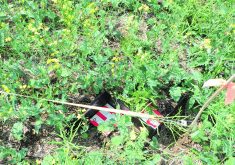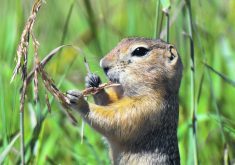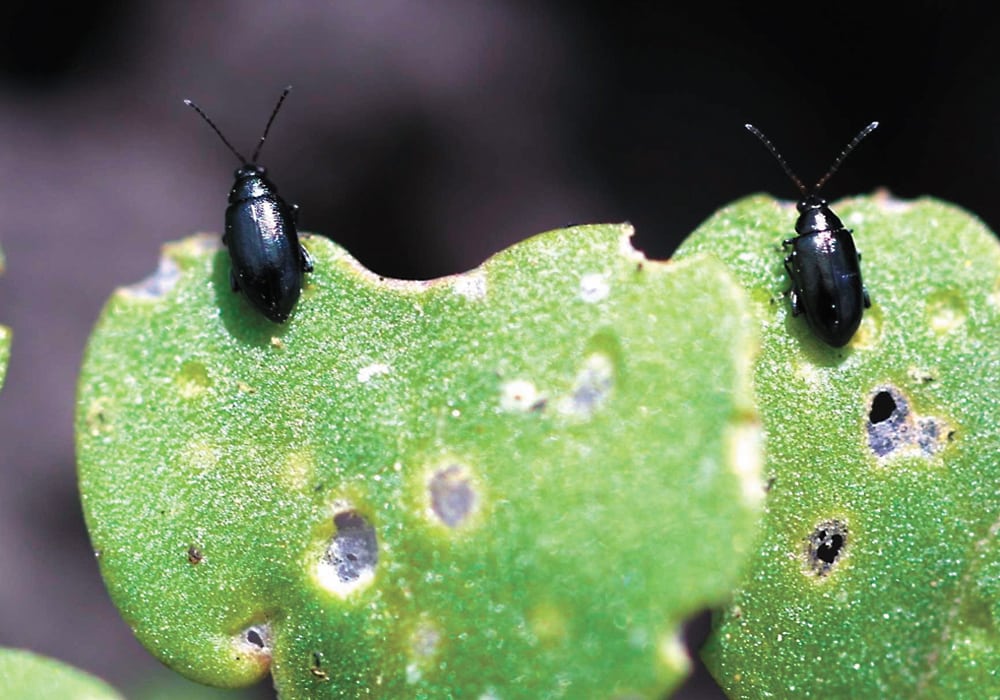Spending a toonie to prevent a loonie’s worth of damage doesn’t make sense.
The same principle applies when deciding whether to spray flea beetles in young canola crops. The visual signs of leaf decimation can be enough to make even the most seasoned veteran canola grower call in the sprayer.
Conventional wisdom says to start thinking spraying when 25 percent defoliation is visible.
However, 25 percent defoliation when the beetles are going away is far different than 25 percent when defoliation is getting worse.
Read Also

Growing garlic by the thousands in Manitoba
Grower holds a planting party day every fall as a crowd gathers to help put 28,000 plants, and sometimes more, into theground
Making that distinction is the difference between saving money or spending $5 per acre on chemical as well as application costs, says to Canola Council agronomist Greg Sekulic.
“Defoliation in the range of 25 percent is the level at which you should start regular scouting,” Sekulic said.
“If you have 50 percent defoliation from flea beetles, the plants will easily recover with no loss of yield. We know that flea beetle damage always occurs when the plant is young and the cotyledon is capable of new tissue growth. Timing is the other factor. Spraying too soon, when numbers are still low, does nothing to protect the crop if a larger invasion occurs later.”
Sekulic said a larger danger does loom below the leaves, even when leaf damage is less than 25 percent. Water and nutrients cannot travel up to the leaves if the beetles settle in on the stems and girdle them.
“That’s a lot more serious than leaf damage,” he said.
“It doesn’t take much effort by the beetle to girdle the stem and kill the young plant. If they’re on the stems, you should spray even if leaf damage is way below 25 percent.”
Research shows that there can be plant losses without yield loss when plant populations are in the recommended range of seven to 14 per sq. foot.
“In fact, some of our modern varieties registered in the past five or six years can maintain their high yield when populations are well below seven per sq. foot.
“We just don’t have the numbers yet to back that up. But judging by the reduced seeding rates we’re seeing lately with these new varieties, I’d say farmers have already figured out how low they can go with plant populations.”
Most flea beetles on the Canadian Prairies are either the crucifier or striped species. It’s important to recognize the difference, and especially to know the differences in their life cycles.
Crucifier beetles are all black, while striped beetles have two cream coloured stripes down their backs. They are the species that are increasing in some regions.
Striped flea beetle adults emerge each spring, one to four weeks earlier than crucifier adults. Peak emergence of crucifier flea beetles occurs when soil temperatures reach 15 C.
Striped flea beetles can be more tolerant of seed treatment insecticides.
Flea beetles need to eat foliage from treated plants to take in the chemical, which is why some leaf feeding should be expected before beetle numbers diminish.
Sekulic said farmers should consider five factors before spraying:
The economic threshold is when canola plants have 50 percent leaf defoliation over a wide area. Check 20 plants at 10 sites throughout a field.
Flea beetles move into a field from the edges, so check the middle of the field to get a true picture of how widespread they are.
Sekulic defines economic threshold as “spraying within the window when the application cost matches the economic return from the spray operation.”
He said entomologists have developed a 25 percent action threshold because a crop can go from 25 percent to 50 percent leaf defoliation in a short time under intense flea beetle feeding.
Leaves are the food of choice for flea beetles, but cool weather forces them down to feed on the stems, where they can do a lot of permanent damage in a hurry. This may require a quick decision.
A stand of seven plants per sq. foot can easily recover to give a normal yield. It’s time to spray if the count drops to four or five plants per sq. foot.
Spraying is probably not needed if the newest leaves are growing fast and have not been affected by the beetles. This is true even if the cotyledons have experienced heavy damage. However, spraying may be needed if new leaves reach 25 percent defoliation and beetles continue to feed.
After the four-leaf stage, canola plants are established to the degree that they can outgrow flea beetle feeding without economic loss. If the crop is uneven, keep scouting until most of the plants have passed the four-leaf stage.
“Look closely. If some plants are heavily damaged and others aren’t, check to see if the damaged plants are growing between the rows,” Sekulic said.
“If they’re volunteers, they won’t have seed treatment. Volunteers rarely provide a positive contribution to yield and are not worth protecting.
“I strongly suggest that growers not jump the gun on spraying flea beetles.
“Give the natural controls a chance to do their work. They have a natural life cycle. They’ll start to drop off on their own. The other factor is the seed treatment. High rate treatments are active for about five weeks after seeding. The insects only need a couple small bites of that and they die.”
For more information, contact Greg Sekulic at 780-832-2382 or visit www.canolawatch.org.


















